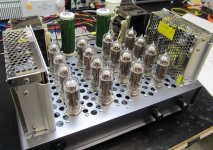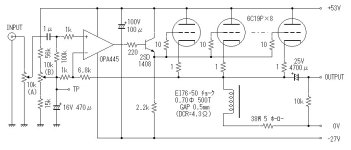I came across a OTL amp using a parallel string of 6AS7 or 6080 on the top and a huge inductor on the bottom. I can't find the Japanese article again. I did come across a simpler and abbreviate schematic dated 1952, see attached, but it wasn't the same circuit. Is anyone familiar with such a circuit?
I built the P. Dickie Jr & A. Macovski (June 1954) circuit but increased the output to 9 parallel per channel to handle 8 ohms speakers which I thought might be reconfigured to the SE design if I can find it.
p

I built the P. Dickie Jr & A. Macovski (June 1954) circuit but increased the output to 9 parallel per channel to handle 8 ohms speakers which I thought might be reconfigured to the SE design if I can find it.
p
https://www.diyaudio.com/community/threads/6c19p-se-otl.132288/
Not sure if that is the official schematic though.
Not sure if that is the official schematic though.
Sorry, I found the circuit. Someone else had posted it in a different thread.
https://www.diyaudio.com/community/threads/6c33c-otl-dc-schematic-needed.169017/
Amazing, this is the circuit I found in an old library book when I was living in Japan +30 years ago!
P
https://www.diyaudio.com/community/threads/6c33c-otl-dc-schematic-needed.169017/
Amazing, this is the circuit I found in an old library book when I was living in Japan +30 years ago!
P
For the 0.64H inductor mentioned in the link in post #4, use two C-40X Triad inductors (320 mH, 600 ma) in series. They are inexpensive.
ray
ray
Hammond 159Y should work too, 600mH 750mA. I used DIY chokes in my SE OTL, 600 turns of 0,5mm wire on EI78 cores if I remember correctly.
C-40X Triad inductors: I looked at the spec sheet. It doesn't show the self resonance.
Many inductors have poor frequency response unless specially wound and choice of core material.
Or in the case of the schematics i posted or provided a link, two inductors are used to reduce that issue.
Many inductors have poor frequency response unless specially wound and choice of core material.
Or in the case of the schematics i posted or provided a link, two inductors are used to reduce that issue.
In my experience, self resonance is not a big problem in applications like this. The chokes doesn't have anywhere near as many turns as the usual plate chokes with tens or hundreds of Henries and the cathode of a power tube has a much lower output impedance than the anode of a driver tube.
I've used regular filter chokes as loads for cathode followers several times and never had any problems with resonaces or limited bandwidth.
I've used regular filter chokes as loads for cathode followers several times and never had any problems with resonaces or limited bandwidth.
Fuling:
Hmmh, my understanding or misunderstanding of the purpose of the choke was that it provides path for the DC idling current of the cathode follower, but to stop the flow of AC( audio) . So the inductor has to behave as an inductor through the audio frequency range of interest and hopefully more( reduce phase shift?) It shouldn't have much capacitance( ie inductor's self resonance should be above 20kHz or more) If an inductor had a low self resonance the circuit would of course still work, but I don't think its frequency response would be flat as the frequency nears the inductor's resonnance.
I've been saving some large cut core inductors. I will warm up my gain phase analyser this weekend and check them!
P
Hmmh, my understanding or misunderstanding of the purpose of the choke was that it provides path for the DC idling current of the cathode follower, but to stop the flow of AC( audio) . So the inductor has to behave as an inductor through the audio frequency range of interest and hopefully more( reduce phase shift?) It shouldn't have much capacitance( ie inductor's self resonance should be above 20kHz or more) If an inductor had a low self resonance the circuit would of course still work, but I don't think its frequency response would be flat as the frequency nears the inductor's resonnance.
I've been saving some large cut core inductors. I will warm up my gain phase analyser this weekend and check them!
P
1/4 the output power of a choke;Wonder how a silicon CCS would fare in place of the choke?
the max current swing into the load with CCS is the CCS's standing current when tube goes into cutoff;
the max current swing into the load with inductor is twice the idle current, because choke can release energy stored when tube conducts;
2x the current = 4x the power
and power dissipated by CCS is power wasted
I did an amp with one of those 600mH Hammond chokes and three 6C41C per channel . It needed feedback , sounded ok but only a few watts . Extremely inefficient . I went over to mosfet followers and DHT drivers , a much easier way of doing 'OTL'
Fuling:
Hmmh, my understanding or misunderstanding of the purpose of the choke was that it provides path for the DC idling current of the cathode follower, but to stop the flow of AC( audio) . So the inductor has to behave as an inductor through the audio frequency range of interest and hopefully more( reduce phase shift?) It shouldn't have much capacitance( ie inductor's self resonance should be above 20kHz or more) If an inductor had a low self resonance the circuit would of course still work, but I don't think its frequency response would be flat as the frequency nears the inductor's resonnance.
I've been saving some large cut core inductors. I will warm up my gain phase analyser this weekend and check them!
P
Your understanding is correct as far as I can tell. My point was that lo Z cathode followers seem to be able to "override" some of the irregularities caused by the capacitances/resonanses of the chokes. I have at least three amps that uses choke loaded cathode followers to drive the power tubes into class A2, the only time I've noticed anything strange was in my 807 PP monoblocks that measured horribly above a few kHz until I replaced the Edcor transformers I used as balanced cathode loads with a pair of Lundahl plate chokes.
My 807 SE monos uses small Hammond 30H 40mA chokes as cathode loads for the 6E5P drivers and my 808 SE uses unknown chinese 40H 50mA chokes in the same position.
- Home
- Amplifiers
- Tubes / Valves
- 6AS6/6082 SE OTL amp with an inductor

